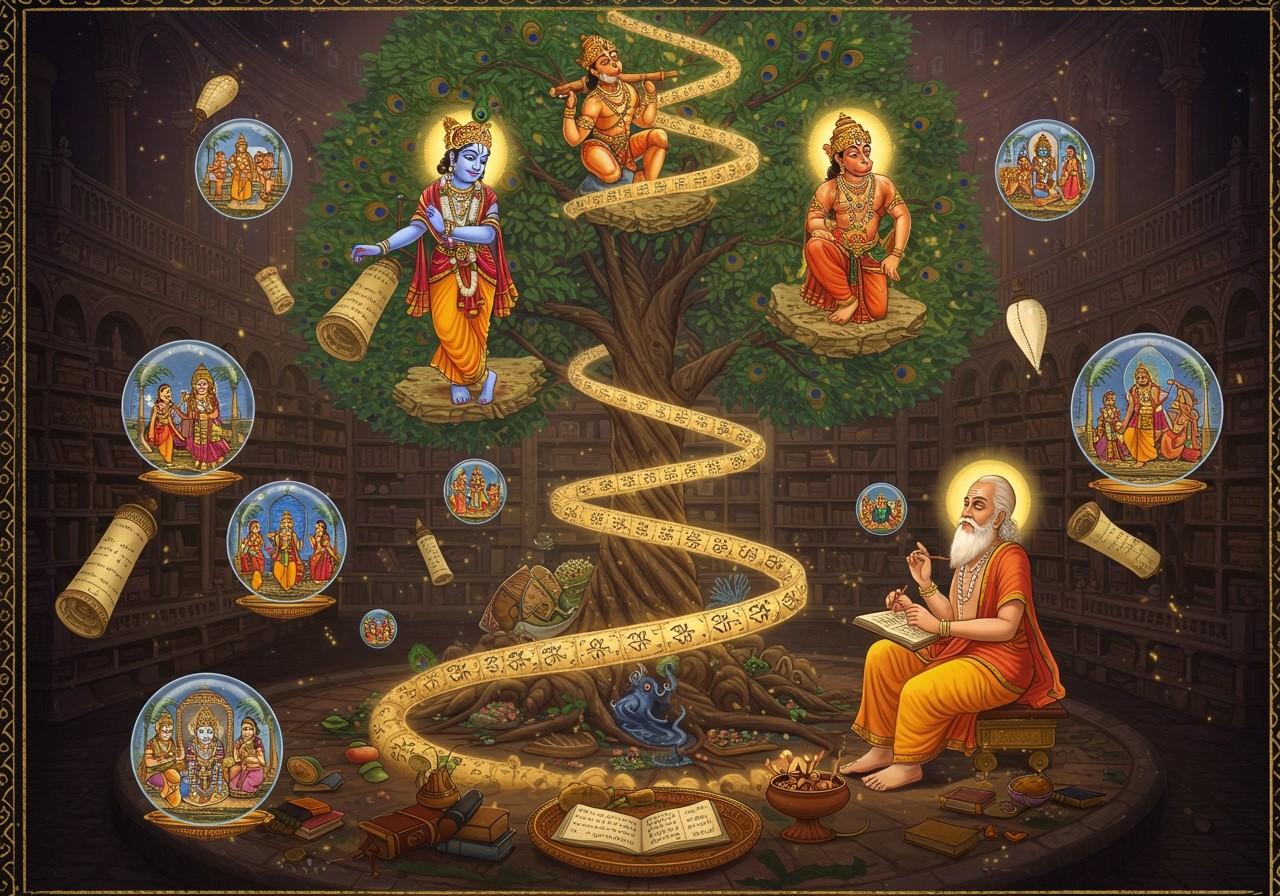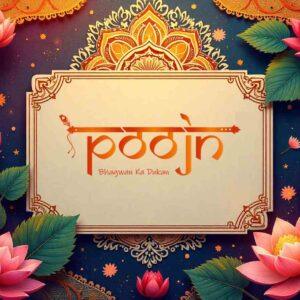
The Itihasa-Purana tradition stands as a cornerstone of Hindu culture, weaving together history, mythology, and philosophy. For those deeply rooted in Indian culture, understanding this tradition unlocks the richness of their heritage. This exploration begins by defining ‘Itihasa’ and ‘Purana’, terms encompassing epic narratives and mythological texts central to Hindu thought. These narratives offer profound insights into the spiritual and cultural ethos of ancient India.
What is Itihasa-Purana?
‘Itihasa’, derived from Sanskrit, translates to ‘thus indeed it was’, signifying historical narratives interwoven with spiritual teachings. The Mahabharata and the Ramayana, two epic poems, exemplify Itihasa. These narratives blend historical events and profound spiritual lessons. ‘Purana’, meaning ‘ancient’, denotes mythological texts narrating stories of deities, cosmology, and legends. Among them, the Bhagavata Purana holds particular reverence. Together, Itihasa and Purana create a comprehensive narrative tradition, chronicling the divine and human aspects of the universe, offering a deeper understanding of Hindu beliefs and practices.
The Itihasa-Purana Tradition: A Deeper Dive
The Itihasa-Purana tradition is integral to Hindu mythology and history. Rooted in sacred texts like the Vedas, Ramayana, Mahabharata, and Puranas, it provides a vibrant tapestry of ancient Indian life, intertwining historical events with spiritual teachings, offering a comprehensive understanding of Hindu beliefs.
The Intertwining of History and Mythology
Itihasa encompasses epic narratives such as the Ramayana and Mahabharata. More than mere stories, these epics convey profound moral and ethical teachings. They serve as guides for righteous living and understanding the consequences of actions. Purana, meaning ‘ancient,’ comprises narratives of deities, cosmology, and legends. These texts are essential for grasping the spiritual core of Hinduism. They illuminate the divine realm and its interplay with the human world.
Shaping Hindu Beliefs and Practices
The Itihasa-Purana tradition has profoundly shaped Hindu beliefs and practices. Through allegorical tales, it simplifies complex philosophical concepts, making them accessible to all. These stories provide insights into dharma (righteousness) and karma (action and consequence), central tenets of Hindu philosophy. They offer practical guidance for navigating life’s complexities.
Bridging Myth and Reality in History and Culture
These texts act as a historical record, bridging myth and reality. They illuminate ancient India’s societal norms, political structures, and forms of governance. They offer a glimpse into the past, providing context for present-day practices. This tradition fosters a sense of identity, connecting past generations with the present. It emphasizes the cyclical nature of time, a core belief in Hinduism. This cyclical understanding provides a framework for understanding life, death, and rebirth.
Relevance in the Modern World
The Itihasa-Purana tradition continues to inspire art, literature, and cinema in contemporary society. It provides a rich source of creative inspiration. It enriches educational curricula, exploring philosophical and ethical dimensions that remain relevant today. This tradition encourages critical thinking and moral reflection. In the digital age, increased accessibility fosters wider appreciation and understanding of Hindu culture. Online resources and digital platforms have made these ancient texts more readily available to a global audience.
Significance for UPSC Examinations
For UPSC aspirants, a strong grasp of this tradition is crucial. It forms a significant part of the Indian history and culture syllabus. Questions often focus on the historical context, authorship, and socio-political impact of these texts. Understanding these aspects is essential for success in the examination. Mastering this tradition provides a solid foundation for understanding Indian history and culture.
Connecting with Tradition: Resources from Poojn.in
Poojn.in, India’s leading cultural goods and services store, provides a wide selection of products to help you connect with the rich Itihasa-Purana traditions. Here are some examples:
-
Sacred Texts: Discover authentic copies of the Ramayana, Mahabharata, and various Puranas in multiple languages. These texts are essential for deepening your understanding of the Itihasa-Purana tradition. Explore various editions and translations to suit your preferences.
-
Deity Idols: Find meticulously crafted murtis of various avatars, including Rama, Krishna, Narasimha, and Varaha. These idols serve as focal points for devotion and contemplation. Choose from a variety of materials and sizes to enhance your personal altar or prayer space.
-
Puja Accessories: Acquire traditional items such as brass lamps, conch shells, and bells used in avatar worship. These accessories enhance the sanctity of your rituals and create a sacred atmosphere. Explore our diverse collection to find the perfect items for your puja needs.
All products at Poojn.in are sourced from trusted vendors who adhere to traditional manufacturing methods. Each item comes with detailed care instructions and basic puja guidelines. Visit www.poojn.in or consult our experts for personalized guidance on selecting the right items for your spiritual practices.
Embracing the Timeless Wisdom
The Itihasa-Purana tradition is more than just a collection of ancient stories. It’s a rich tapestry of history, mythology, and philosophy that guides us toward understanding the essence of Hindu culture. These texts offer profound insights into dharma and karma, shaping our beliefs and actions. In today’s world, these timeless teachings offer solace and direction. They remind us of the values that unite us as a community. Whether you are a student, a spiritual seeker, or someone who cherishes tradition, embracing the wisdom of Itihasa-Purana enriches your life’s journey, connecting you to the heart of Hindu heritage.
Frequently Asked Questions about the Itihasa-Purana Tradition
What does Itihasa-Purana encompass? The term refers to ancient Indian texts narrating history and mythology. Itihasa includes epics like the Mahabharata and Ramayana, while Puranas are collections of mythological stories, traditions, and historical events. These narratives provide a comprehensive view of ancient Indian culture and beliefs.
Why is this tradition important? It is crucial for preserving Hindu culture, values, and beliefs. These texts offer insights into ancient Indian society, moral values, and religious practices, providing a framework for understanding the evolution of Hinduism.
What distinguishes Itihasa and Purana? Itihasa focuses on epic narratives like the Mahabharata and Ramayana, while Puranas are more encyclopedic, covering various topics like cosmology, genealogies, and legends. Both are interwoven with spiritual and philosophical teachings.
What can be learned from this tradition? We gain insights into ancient Indian history, mythology, cultural values, and moral lessons. The stories provide guidance on righteous living and understanding the consequences of actions.
Is this tradition still relevant today? Yes, it remains a source of cultural identity and moral guidance. It influences modern Hindu practices and beliefs, offering timeless wisdom for navigating contemporary challenges.


